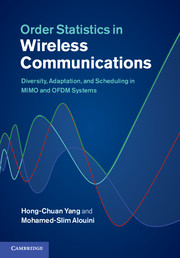 Order Statistics in Wireless Communications
Order Statistics in Wireless Communications 7 - Multiuser MIMO systems
Published online by Cambridge University Press: 07 October 2011
Summary
Introduction
Multiple-antenna transmission and reception (i.e. MIMO) techniques can considerably improve the performance and/or effciency of wireless communication systems. First introduced in mid 1990s [1, 2], MIMO technique has been an area of active research and has found applications in various emerging wireless systems. Most of early MIMO designs focus on point-to-point link where both transmitter and receiver have multiple antennas and demonstrate the huge potential of MIMO techniques in terms of providing array gain, spatial diversity gain, spatial multiplexing gain and interference reduction capability, among many others [3–5]. Meanwhile, most mobile receivers will possess less antennas than the base stations in the near future due to their size/cost constraints. In such scenarios, the capacity of a point-to-point link between the base station and a mobile will be limited by the number of antennas at the mobile. On the other hand, if we consider the antennas of different receivers together, a virtual MIMO system is formed with huge capacity potential [6–10]. The design and analysis of effcient transmission strategy for resulting multiuser MIMO systems is the subject of this chapter.
A rich literature on MIMO wireless communications already exists. There has already been a rich literature on MIMO wireless communications. Several books have been published on this general subject (see for example [11,12]). This chapter complements existing literature on MIMO wireless communications by focusing on the different multiuser scheduling schemes for multiuser MIMO systems. In general, the downlink transmission from the base station to mobile receivers is more challenging in the multiuser MIMO system, as mobile users are randomly distributed and cannot perform joint detection.
Information
- Type
- Chapter
- Information
- Order Statistics in Wireless CommunicationsDiversity, Adaptation, and Scheduling in MIMO and OFDM Systems, pp. 193 - 244Publisher: Cambridge University PressPrint publication year: 2011